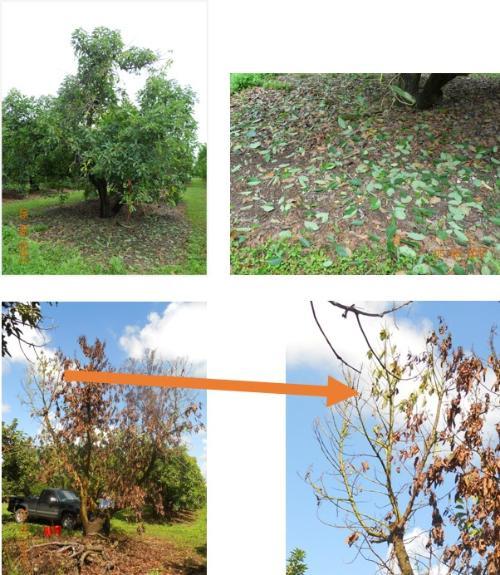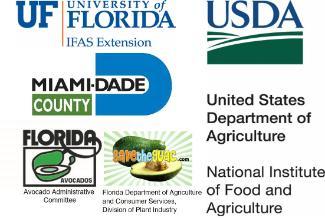Threat to Florida's Avocados and Native Trees in the Laurel Family
The redbay ambrosia beetle, Xyleborus glabratus, and its fungal symbiont, Raffaelea lauricola (Rl), were introduced into Port Wentworth, Georgia, USA, in infested wood packing material from Asia during 2002. This insect-disease complex, commonly called laurel wilt (LW), affects trees in the Lauraceae family and spreads through natural areas by redbay ambrosia beetle movement and anthropogenic movement of infested wood products (e.g., firewood, wood-turners wood, and BBQ smoke-wood). Plant hosts of the redbay ambrosia beetle-Rl complex include at least ten native lauraceous woody species (e.g., redbay [Persea borbonia] and swamp- bay [P. palustris]) in Florida, as well as non-native species such as camphor (Cinnamomum camphora), avocado (P. americana), and potentially California bay (Umbellularia californica). By February 2010, redbay ambrosia beetles were detected in a natural area 21 miles (33.7 km) north of the south Florida avocado production area (125 sq. miles; 324 sq. km) in Miami-Dade County. In 2011, the first confirmed swampbay tree to succumb to LW was documented in this natural area, and by 2012 LW was detected in a commercial avocado grove in Homestead, Florida.
The laurel wilt-ambrosia beetle complex continues to threaten Florida’s avocado industry despite 14 years of research to find an entirely effective control program. To date the loss of over 140,000+ commercial avocado trees can be attributed to LW; worth an estimated $46.2 million. This is because little to nothing was known about the fungal phytopathogenic symbiont, Raffaelea lauricola (Rl; causal agent of the disease) when it was introduced into the US in 2002 and the unexpected lateral transfer of Rl from the initial ambrosia beetle vector, Xyleborus glabratus, to at least nine other ambrosia beetle species that are the primary carriers of the pathogen in avocado systems. Large populations of these beetles commonly inhabit avocado groves and three species, X. bispinatus, X. volvulus and Xyleborinus saxeseni have been implicated in transmission of the pathogen to avocado trees. These beetles have a short flight period of ~1 h before sunset and usually colonize trees that are physiologically stressed. The rapid movement of the pathogen within and among adjacent root-grafted avocado trees, the rapid rate of decline (4-8 weeks after symptoms onset) of avocado trees in response to the pathogen, and the ability of ABs to reproduce rapidly well protected inside the trees, have made development of economically feasible control tactics difficult. Additional challenges include the proximity of natural areas harboring LW susceptible hosts and back yard avocado trees serving as reservoirs for the pathogen and routes of dispersal among avocado groves.
At present LW has been detected in 11 southeastern US states, including Alabama, Arkansas, Florida, Georgia, Kentucky, Louisiana, Mississippi, North Carolina, South Carolina, Tennessee, and Texas (Fig. 1; US Forest Service 2019), and in all of Florida’s 67 counties. Laurel wilt is now endemic in the avocado production area of Miami-Dade County. There is great risk for introduction of LW into California, Mexico, and Central and South America through natural spread of the redbay ambrosia beetle through natural areas and by movement of infested wood material (e.g., firewood).
-500x392.png)
Photo Credit: U.S. Forest Service
Further Details
The LW susceptibility of 24 container-grown avocado cultivars of varied genetic backgrounds was tested, and those of Guatemalan × Mexican background (e.g., ‘Hass’, ‘Winter Mexican’) were less quickly affected by LW inoculation than avocado cultivars of Guatemalan × West Indian (e.g., ‘Miguel’) background, which were less quickly affected than West Indian (e.g., ‘Simmonds’ and ‘Donnie’) cultivars. This suggests there may be some variability in how rapidly symptoms of LW progress dependent upon genetic background. In addition, symptom severity was positively correlated with plant size; larger plants declined more rapidly to infection by the LW pathogen than smaller plants.
In commercial groves, mature trees of 32 avocado cultivars of various genetic backgrounds have been documented to succumb to LW (Table 1). No mature avocado trees of any cultivar have been discovered to be tolerant to the LW pathogen so far. Recent greenhouse studies have shown that the rate of LW disease progression (i.e., the speed of symptoms development) is related more to the scion than the rootstock, but the rootstock does have some influence (B. Schaffer, personal observations). No tolerant scion or rootstock has been confirmed to date, but work is underway to try to identify LW-tolerant scions, rootstocks, and scion/ rootstock combinations.
In mature avocado groves, LW disease spreads by root grafts among adjacent trees and by ambrosia beetle (AB) infestations. Via root grafts the pathogen may move at a rate of three to six new trees per month; this can result in the loss of 90 or more trees in a six-month period. The visible external symptoms of laurel wilt disease in avocado begin as green-leaf wilting, typically in one section of the tree (Photo 1). Frass straws resulting from AB boring may be evident, and the sapwood often has blackish-blue-stained streaks. As the disease progresses, leaves desiccate, turn brown, and usually remain attached to the branches (for up to about 12 months), and tree dieback progressively takes over more sections of the tree. Occasionally, copious leaf drop occurs at the early stages of infection, but subsequently tree dieback and death commence (Photo 2). In both cases the tree eventually dies, although sometimes if the tree is left in place or is cut to a stump, it may regrow from the stump or large roots (Photo 3). There are conflicting reports regarding the recovery of LW-infected trees after stumping (~4 ft; ~1.2 m height).
Some have reported trees regrow canopy and appear disease-free, but this regrowth may die back repeatedly until the tree is dead.Others have reported that stumped trees regrow their canopy and resume fruit production after two to three years. How frequently regrowth and fruit production resume are not known and are under evaluation.
-500x446.png)
Laurel wilt affected avocado trees and symptoms of ambrosia beetle boring. Credit: JH Crane, UF/IFAS/TREC

A mature laurel wilt affected tree with sections of the tree with copious leaf drop while leaves remain on stems in other sections of the tree prior to decline and death.

Regrowth and some branch dieback of a tree cut to a stump (~4 ft height) and tree growth that has died back.
Current Research Findings
- The LW pathogen is highly virulent and moves through the xylem rapidly within avocado trees and among mature root-grafted avocado trees. As few as 39 CFU (colony forming units) can induce symptoms of LW and the eventual death of mature avocado trees.
- Prophylactic injection of propiconazole (Tilt®) every 12 to 24 months appears to be effective in protecting avocado trees from developing symptoms of LW. However, the time from injection to systemic coverage within a tree takes seven to eight months.
- Ambrosia beetles implicated in Rl transmission are present year-round and their flight activity increases during late winter–early spring.
- Groves with higher light levels have significantly reduced AB abundance compared to groves allowed to form dense canopy resulting in shaded conditions (Photo 5). Pruning (hedging, topping or selective pruning) to maintain higher canopy and grove light levels, re-establishing tree canopies (rejuvenating old non-productive trees) with severe pruning (e.g., hat-racking or stumping trees to four ft) and top-working large trees increase grove light levels and suppress AB activity.
Ongoing and Future Research
The research into the biology and strategies to control and mitigate the LW epidemic continue. Control tactics that show promise include:
- Underlying biotic and abiotic factors that cause physiological stress on avocado trees making them attractive to ambrosia beetles,
- Push-pull (trap-kill) systems to repel, attract and kill AB,
- Understanding the microbiome of AB and how they may be manipulated to suppress AB populations,
- Cross protection of avocado trees with nonpathogenic species of Rl or other less virulent vascular fungi or non-viable Rl,
- Search for, document, and monitor healthy productive avocado trees that are positive to Rl to better understand how they are surviving the pathogen infection,
- Understanding the physiology scion-rootstock relationship and responses to Rl, and
- Understanding the molecular basis for disease development and how it may be manipulated to provide avocado trees tolerance to the pathogen.
- Understanding the effect of cultural practices on the ability of ambrosia beetles to infest avocado trees and that affect the progression of the disease.
Control Recommendations
- Promote and maintain healthy trees through proper fertilizer, irrigation, and pest management. Poorly maintained and environmentally stressed trees (e.g., affected by drought, flood, drought, other diseases, wind/storm damage and/or freeze exposure) are attractive to AB and increase their chances of being colonized by AB carrying Rl.
- Scout groves to detect trees with early LW symptoms such as green-leaf wilting. The earlier infected trees are removed and destroyed, the more likely the disease outbreak may be contained. When trees are showing symptoms associated to lates stages of disease progress (i.e., large segments of the canopy with desiccated foliage), the LW pathogen has probably already moved through root grafts to adjacent health trees.
- Rogue (uproot and chip/shred) LW-affected trees immediately upon detection. Severing the root system of adjacent trees is the most important step to limiting the spread of the pathogen to root grafted adjacent trees. In addition, rogueing helps to reduce AB populations by destroying the galleries where they reproduce. Spray the chipped or shredded wood twice with a contact insecticide. Insecticides registered for use on avocado include Malathion, Danitol®, Agri-Mek®SC, Talstar®S, Hero® (nonbearing trees only), Botanigard®, and Mycotrol® (Beauveria bassiana).
- Two trunk and lower limb directed contact insecticide applications (fifteen days apart) should be made to protect the healthy trees within a one-acre area of the rogued LW-affected tree.
- During late winter–early spring, when AB populations and activity increase, apply two grove-wide applications of the mycoinsecticides BotaniGard®ES or Mycotrol® (Beauveria bassiana) to suppress AB populations.
- Productive groves with the lower canopy intact should be pruned annually to maintain canopy light levels and production. Groves with overgrown trees that have lost their lower canopy should be rejuvenated, i.e., cut back to four to eight feet to re-establish the lower canopy and then maintained at a height no higher than two-thirds the distance between rows. The re-established productive canopy of top-worked trees grafted to alternative cultivars should also be pruned to maintain the new productive lower canopy through regular pruning.
- Consider injecting non-LW affected groves prophylactically with propiconazole (Tilt). If this is not possible, rogue LW-symptomatic trees and inject all remaining healthy appearing trees. Some loss of these trees may be expected due to the spread of the pathogen prior to injection. When additional avocado trees show LW symptoms, remove them as soon as possible. Injected trees will need to be reinjected on at 12 to 24-month interval depending upon pest pressure.
Mitigation Recommendations
Replant avocado trees lost to LW to reestablish future fruit production and maintain economic viability. Movement of the LW pathogen by tree-to-tree root grafting is not an issue in young trees because it takes many years for root grafts to form, young trees are not a preferred host of AB, and the high light exposure of the area around these trees suppresses AB activity.
Find more detailed information on scouting and sampling for LW and recommendations for commercial growers and homeowners with avocado trees in their landscape.
The authors thank the following supporting entities: USDANIFA grant 2015-51181-24257: Laurel Wilt of Avocado: Management of an Unusual and Lethal Disease; University of Florida Institute of Food and Agricultural Sciences; the Florida Avocado Administrative Committee; UF/IFAS Extension Miami-Dade County; and Florida Department of Agriculture and Consumer Services, Division of Plant Industry.
Other Acknowledgements
- UF/IFAS Extension Miami-Dade County
- Florida Avocado Administrative Committee
- California Avocado Commission
- University of California Extension

Tropical Research & Education Center
18905 SW 280 Street
Homestead, FL 33031
Phone: (305) 246-7000
Fax: (305) 246-7003
E-mail: jhcr@ufl.edu


-500x392.png)
-500x446.png)


